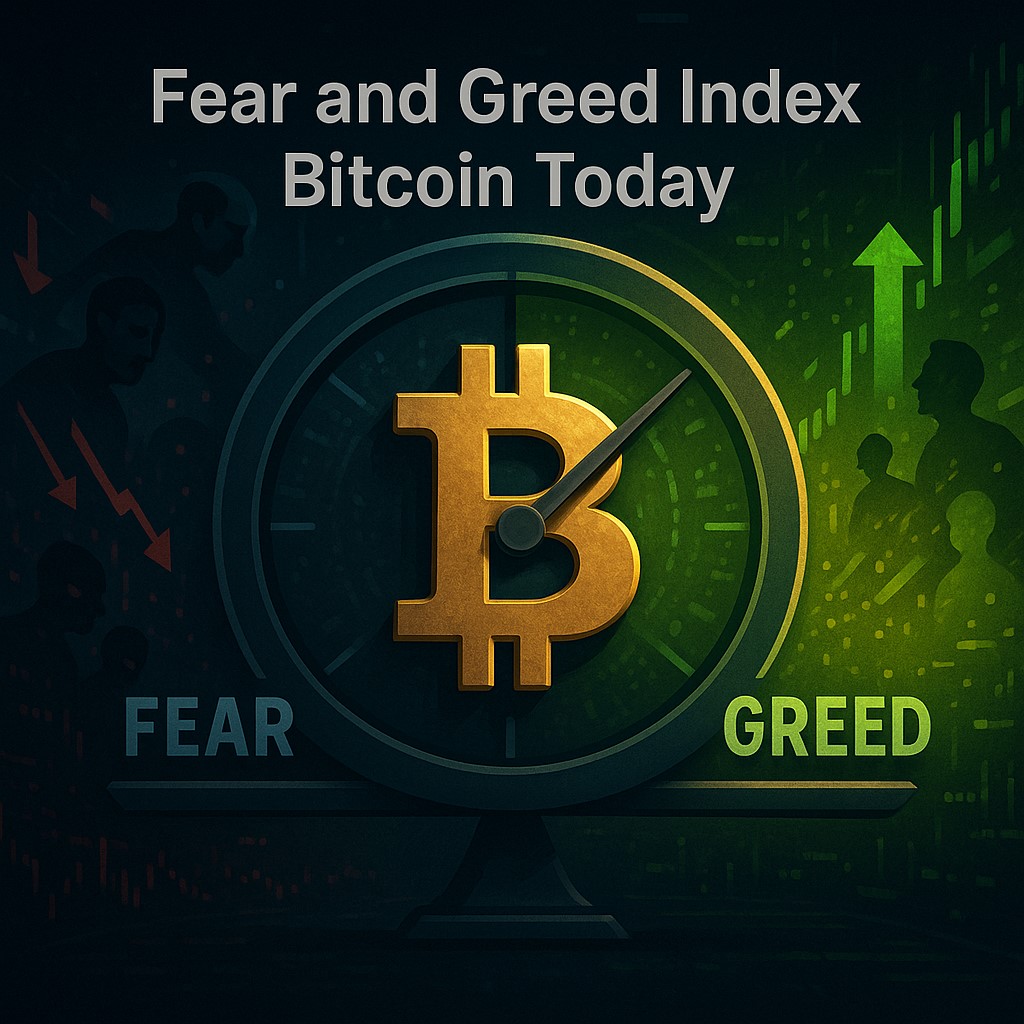Understanding what drives Bitcoin price action often begins with understanding the mood of the market. Traders look at charts and technical indicators, but the emotional climate behind those moves matters just as much. The Bitcoin Fear and Greed Index captures this climate in a single score. Knowing how to read and interpret that score can help you make better decisions and avoid emotional traps. This guide explains what the index measures, what Bitcoin sentiment looks like today, and how you can use it as part of a smart trading strategy.

Table of Contents
What the Bitcoin Fear and Greed Index Measures
The Purpose of the Index
Every market runs on emotion. Investors react to news, price swings, and even social media narratives. The Bitcoin Fear and Greed Index was created to quantify this emotion so traders can see whether the crowd is nervous or overly confident. Its goal is simple: offer a fast way to gauge sentiment and highlight moments when the market may be stretched in one direction.
Fear often appears after steep drops or negative headlines. Greed rises during strong rallies when traders start chasing quick gains. By measuring this balance, the index helps traders understand the psychological context behind Bitcoin’s movement.
How the Score Works
The index ranges from 0 to 100. A score near 0 signals extreme fear. A score near 100 signals extreme greed. Scores in the middle show a more neutral market.
This scale is helpful because extreme readings often align with market turning points. Extreme fear has historically appeared around local bottoms. Extreme greed has shown up when prices push toward overheated levels. The index does not predict price. It simply highlights emotional extremes that might not be sustainable.
Components Used in the Calculation
Each score is based on several data points. Understanding these helps you see why the index shifts from one day to the next.
- Volatility: Measures how strong recent price swings have been. Sharp drops raise fear levels.
- Market Momentum and Volume: Tracks whether buying or selling pressure dominates the market. Strong upward momentum signals greed.
- Social Media Sentiment: Examines engagement and tone across key platforms.
- Bitcoin Dominance: A rising dominance can signal flight to safety. Falling dominance often means broader risk appetite.
- Google Trends and Search Behavior: Tracks what people are searching for, such as fear-driven queries during downturns.
Together these elements create a daily snapshot of market psychology.
Bitcoin Fear and Greed Index Today: Current Reading and Market Mood
Today’s Score and What It Signals
The Fear and Greed Index for Bitcoin currently stands at 11, indicating an “Extreme Fear” level. This reflects pronounced caution and risk aversion among Bitcoin investors right now. Bitcoin’s price fell approximately 5.5% over the past 24 hours to around $95,383, reacting sharply to macroeconomic pressures and the Federal Reserve’s recent decision not to cut interest rates in December. This decision heightened risk-off sentiment across global markets, prompting tighter liquidity and increased selling pressure. Understanding this emotional environment helps traders discern whether price movements stem from rational decisions or emotional swings.
Key Drivers Behind Today’s Sentiment
Several factors shape today’s market mood. Recent price volatility plays a significant role, with sharp pullbacks typically pushing fear levels higher. Bitcoin’s recent decline has contributed heavily to the current extreme fear reading. Additional influences include macroeconomic data, regulatory updates, and liquidity conditions. Social media chatter and rumors can also shift sentiment within a short time frame.
How Today’s Score Compares to Recent Weeks
Examining the trend over recent weeks provides deeper insight than observing a single day’s reading. The index has dropped steadily from around 34 last month to the current 11, signaling increasing uncertainty and fear in the market. When the index falls sharply like this, it often reflects market participants bracing for ongoing volatility. Comparing today’s reading with historical data helps traders judge whether this is part of a larger market shift or merely a short-term reaction.
Why the Fear and Greed Index Matters for Bitcoin Traders
Spotting Potential Market Extremes
Market extremes often happen when emotions run hot. When fear dominates, many traders sell at any price. When greed takes over, many buy without thinking about risk. Recognizing those moments gives you a clearer view of where opportunities or dangers may lie.
Past cycles show that extreme fear sometimes matches with oversold conditions. Extreme greed sometimes matches with exhaustion in a rally. These patterns are not guarantees. They are signals that deserve attention.
Using the Index as a Supporting Signal
Smart traders rarely rely on a single indicator. The Fear and Greed Index works best when combined with technical tools such as trendlines, moving averages, and BTC/USDT volume analysis. Pairing sentiment with structure helps confirm whether a move is likely to continue or reverse.
For example, if greed is high but Bitcoin is also hitting resistance, caution may be wise. If fear is high and price is bouncing from strong support, patience may reward you.
Avoiding Common Misinterpretations
The biggest mistake is assuming fear means buy or greed means sell. Sentiment alone cannot override the market trend. A fearful market can remain fearful for weeks if larger forces keep pressure on price.
It is important to consider broader context. Understanding the trend, liquidity environment, and major news helps prevent rushed decisions based on emotion.
Strategies for Using the Fear and Greed Index in Bitcoin Investing
Long-Term Investors
Long-term investors often use the index as a broad guide rather than a daily trading tool. During periods of high fear, dollar-cost averaging can help build positions at more attractive prices. During periods of strong greed, long-term investors may choose to slow their buying or secure partial profits.
Short-Term Traders
Short-term traders look for sentiment extremes that could lead to reversals. Rising greed near resistance or rising fear near support can act as early warning signals. Combining these signals with breakout patterns or divergence indicators helps refine entries and exits.
Risk Management Considerations
Sentiment is valuable for risk control. When greed is high, tighten stops, reduce leverage, or scale back risk. When fear spikes, widen your perspective and avoid panic selling. Treat sentiment as a guide for how much exposure is appropriate in a fast-moving market.
Limitations of the Fear and Greed Index
Oversimplification of Market Psychology
The index simplifies a complex market into a single number. It cannot reflect the full range of motivations behind buyer and seller actions. Professional traders, institutional funds, and algorithmic systems do not react to emotion in the same way retail traders do.
Short-Term Focus
The index is designed for short-term sentiment. It does not provide insight into long-term value or structural trends. Relying on it for long-horizon predictions can lead to misleading conclusions.
The Importance of Context
Sentiment should always be viewed within the broader environment. Economic conditions, monetary policy, regulatory news, and liquidity shifts all influence Bitcoin beyond emotional swings. Context ensures the index becomes a tool rather than a trap.
Tools to Track the Bitcoin Fear and Greed Index
Best Real-Time Dashboards
If you want to monitor the index daily, several platforms publish updated scores along with charts and historical comparisons. These sites make it easy to track shifts in sentiment and understand how emotions align with price.
Complementary Sentiment Tools
Additional data can deepen your understanding of market psychology. Useful tools include:
- Funding rates
- Open interest analysis
- Whale activity metrics
- Social sentiment trackers
Using multiple sources gives you a more complete view.
How Often to Check the Index
Daily updates are helpful for active traders. Weekly reviews are often enough for long-term investors. Checking the index too frequently can lead to emotional trading. Use it as guidance rather than impulse fuel.
FAQ
What is the Bitcoin Fear and Greed Index?
It is a daily score that measures market sentiment using volatility, volume, social signals, dominance, and search trends.
Is the index accurate for predicting Bitcoin price?
It is not a predictive tool. It highlights emotional extremes that can help traders spot potential opportunities or risks.
What score is considered extreme fear?
Scores near 0 to 25 usually indicate extreme fear.
What score is considered extreme greed?
Scores from 75 to 100 usually indicate extreme greed.
How should traders use the index?
Use it as a supporting tool alongside technical and fundamental analysis.
Final Takeaway
The Bitcoin Fear and Greed Index is a valuable lens for understanding the emotional forces behind price movement. It cannot forecast the future, but it helps traders identify when emotions reach unsustainable extremes. By pairing sentiment with technical structure, market context, and risk management, you can make more confident decisions.
If you want to take your trading to the next level, consider exploring Bitcoin opportunities on MEXC.
Disclaimer: The information provided in this article is for educational and informational purposes only. It does not constitute financial, investment, or trading advice, and should not be interpreted as an endorsement of any specific project, product, or service. Always conduct your own research and consult with a qualified financial professional before making investment or trading decisions.
Join MEXC and Get up to $10,000 Bonus!
Sign Up


